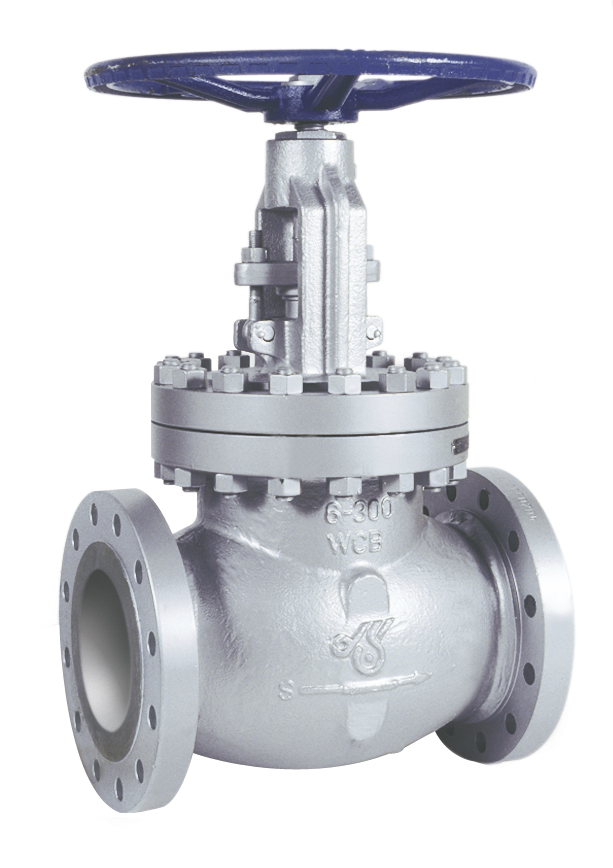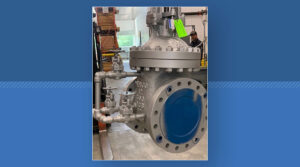
Industrial Globe Valves
Globe valves remain a popular option for industrial applications as their design allows them to excel in both throttling and shut-off purposes. Also, they can handle a variety of process media types due to their robust design. In this article, we review how industrial globe valves work, their applications in industry, and how to select the right one for your project.
How Industrial Globe Valves Work
An industrial globe valve is a linear-acting valve. This means that the valve stem moves upwards and downwards to open and close the valve, respectively, which is similar to rising-stem gate valves. However, a globe valve can throttle because, as its disc lifts from the seat, the increase in flow is proportional.
When examining the operation of industrial globe valves, it is important to review their main components, which are the disc, seat, and stem.
-
- Disc: The disc of the globe valve varies in shape, but usually comes in the form of a ball, composition, or plug. A ball disc is ideal for low-pressure and low-temperature systems. It can throttle but is preferable when flow isolation is important. Similarly, the composition disc can throttle and is good at isolating flow, providing an even tighter closure than a ball disc. As for a plug disc, its long and tapered design helps it deliver better throttling than other types of discs.
-
- Seat: The valve seat interlocks with the disc to create a leak-free seal. It has a baffle that causes the flow to change direction as it goes through the valve. Moreover, this is responsible for the relatively high-pressure drop associated with globe valves. Some globe valves have a back seat that prevents system pressure from affecting the valve packing, thereby extending the valve operation life.
-
- Stem: Globe valves typically use rising stems, whose position indicates whether the valve is open or closed. It is connected to the disc using a T-slot or disc nut.

Operating a Globe Valve
When operating a globe valve, a handwheel connects to the stem and rotates to raise or lower the stem for manual actuation. Alternatively, automatic actuators using pneumatic or electrical means, can also operate the valve via the stem.
Although globe valves are bi-directional, each valve is designed to allow flow in only one direction, which is indicated on the valve body. Typically, the common flow direction is for the pressure application to be from under the valve disc. This makes opening the valve easier and minimizes exposure of packing to system pressure.
However, if the valve is controlling steam or high-temperature media, the appropriate flow direction is for pressure to be at the upper part of the disc when shut off. Because, if the pressure is under the disc, an extended period of closure may result in the valve stem cooling and contracting. This will cause the disc to lift and allow flow through the valve. By keeping the pressure at the upper side, the valve stem remains at the temperature of the flow medium during periods of isolation.
Applications
The reliable performance and versatility of industrial globe valves makes it a popular option across several industries. In this section, we explore some of these applications.
Oil and Gas Industry
Globe valves are a mainstay in the oil and gas industry for controlling the flow of natural gas, crude oil, and other products. Their use is critical, especially upstream, where production fluids are flowing at very high temperatures and pressures.

The presence of globe valves at the wellhead and other upstream equipment reduces fluid pressure, making it safe for downstream equipment. Also, production fluids could be quite corrosive, notably when sulfur content is high. The robust design of globe valves helps to maintain system integrity over long periods, which is key for remote areas such as subsea facilities.
Chemical Industry
The chemical industry relies heavily on globe valves to control the flow of diverse fluids such as solvents, acids, and alkalis. These fluids are not usually at high pressure, but can be quite harsh and corrosive. Having a robust design, strong seated globe valves with either ball or combination disc are ideal for isolation and preventing leakages. Also, its excellent throttling enables accurate metering of chemicals for a variety of processes in this industry.
Energy Industry
Globe valves are effective in the control of steam and water in turbines, boilers, and other power generation equipment. They serve in the metering of cooling water systems, boiler vents, and drains, as well as turbine seals and drains. Because they are minimally affected by shocks and vibrations created by flowing fluid, they are ideal for these applications.
Food and Beverage Industry
Due to their structure, globe valves are easy to clean, maintain, and discourage particle accumulation. This makes it easy to maintain hygiene, which is important in the food and beverage, as well as the pharmaceutical industry.
How to Select the Right Globe Valve
Selecting the right globe valve for your project is crucial to ensuring optimal performance, longevity, and efficiency. Some factors to consider during the selection process include:
-
- Pressure and Temperature: Valve manufacturers always specify the pressure class and temperature rating that each valve can function. When selecting a valve, it is necessary that it meets or exceeds the system’s pressure and temperature requirements.
-
- Media Type: Because industrial globe valves are effective in controlling both gas and liquids, its application is broad. So, it is necessary to assess the chemical composition of the flow media and its compatibility with the valve material. Especially the parts of the valve that will be in contact with the flow.
-
- Flow Coefficient: The valve flow coefficient, or Cv, is a measure of its ability to pass fluid. If a valve’s Cv value is high, then the higher its flow rate. This value is always quoted by the OEM.
-
- Sealing Mechanism: Industrial globe valves have different types of discs that determine the level of control or shut-off. Ball and combination discs are better at providing a tight seal, so they are preferable if the valve will be doing more of flow isolation. Whereas a plug disc provides better throttling, so it is suitable when precise control is a requirement.
-
- Type of Bonnet: Globe valves come in a variety of bonnets such as threaded, welded, bolted, and pressure-sealed bonnets. Threaded bonnets are for low-pressure applications, while welded bonnets provide a more reliable joint as the pressure level gets higher. However, welded bonnets make maintenance difficult. Bolted joints are ideal for high-pressure applications when regular access to inside components is a requirement. However, they become very heavy and may need additional support as pressure requirements increase. Also, at temperatures above 600 ℉ (350 ℃), the load-bearing capacity of the bolts drastically decreases. Pressure seal bonnets are the best for high-pressure, high-temperature applications.
-
- Actuation: The globe valve in use should have an appropriate method of actuation. Actuation method depends on the valve size, required speed of operation, accessibility, availability of utilities, etc.
-
- Maintenance: Like all mechanical equipment, globe valves require some level of maintenance. When selecting a valve, consider if it will be easily accessible for maintenance. Also, spare parts availability and accessibility are pivotal to minimize maintenance costs and downtime.


